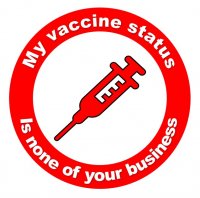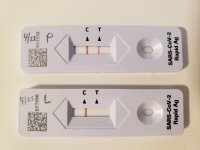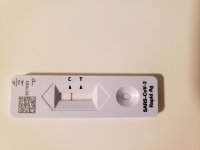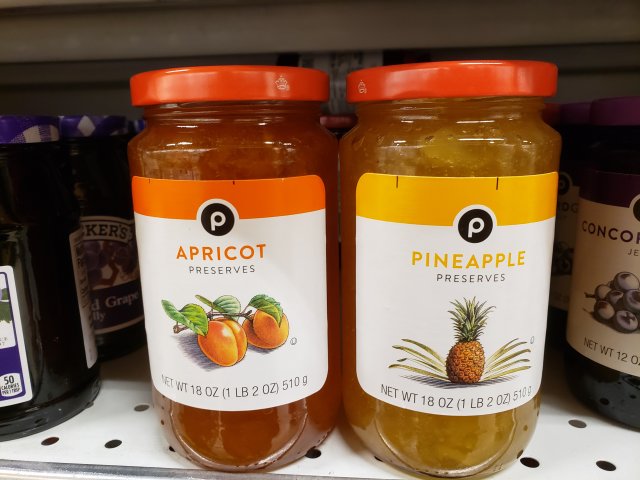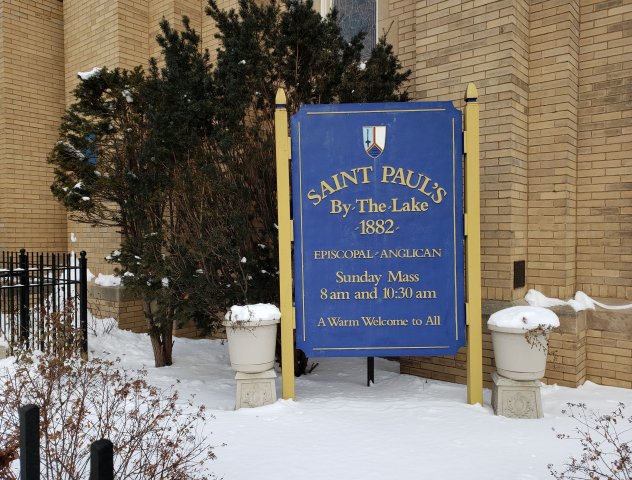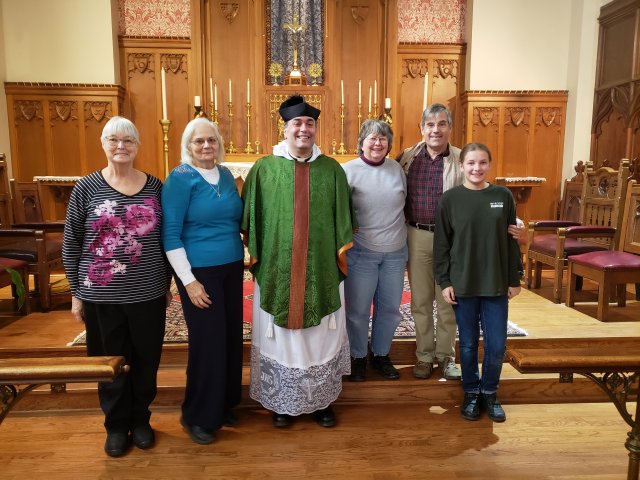Here's another Gordon Ramsay video, especially for our grandson the aspiring dessert chef, whose other grandparents have a plentiful supply of rhubarb growing in their garden (in season). I am envious that Ramsay lives where rhubarb is plentiful and cheap!
The previous language warning applies to whatever random video might come after this on YouTube, but this one is fine.
I think I will tell the story of our recent trip to Europe in topical segments rather than strictly chronologically. The COVID pandemic, being so intimately woven throughout, seems a good place to start.
Our last trip to Europe before the pandemic shut down travel had been in September 2019—to Switzerland (of course) with a side trip to Rome. Then 2020 and 2021 broke our 13-year streak of annual (sometimes more frequently) international travel to visit our international daughter and her family.
Our planned Viking river cruise of 2020 was postponed twice—and then drastically altered thanks to the fact that one of the stops was to have been St. Petersburg (not the city on the west coast of Florida). As part of Viking's compensation for the inconvenience, we acquired along the way a one-week cruise up the Rhône River in France, with an extension that gave us two weeks in Switzerland. Much to my surprise, that one survived.
It seemed fitting to remove, at least temporarily, my Facebook profile picture, which prolaimed—in response to Facbook's pressure to brag about having received the COVID-19 vaccine—that "My vaccination status is none of your business." Because suddenly my vaccination status had become everyone's business. First it was Chicago, where we couldn't attend a concert, visit a museum, or eat in a restaurant without out photo ID and proof of vaccination. This time it was international travel.
I've said many times that I deplore the division of our society into the "clean" (vaccinated) and the "unclean" (unvaccinated), with its harmful (sometimes hateful) discrimination against the latter. I've also admitted that my scruples only go so far. I may willingly cut back on my restaurant meals and museum visits, but seeing friends and family is another issue. We were willing to go through all sorts of bureaucratic hoops to make that happen.
The problem was that those hoops kept changing. Europe started opening up drastically, and so did some of our states. But America's rules regarding international travel remained stuck where they were the first week in December. And Viking chose to keep its own rules very strict. (Wisely, I think, much as I hated them, because how were they to know when the countries involved would change their minds again?) Plus, as we all know, websites are not always kept up-to-date, and we found that one page on a given informational site would contradict another.
But finally, with tests taken, documentation in multiple formats, and unwanted apps installed on our phones, we thought we were ready. The most stressful part was the required pre-travel COVID testing: there's nothing like knowing all your plans could be so easily trashed at the last minute to bring home, once again, the sub conditione jacobaea warning.
Our results were negative, and we boarded the plane for the first leg of our journey, to Montreal. All looked to be going well, as they pronounced all our paperwork to be in order as we waited to board the next flight, this time to Brussels. But at the very last minute (boarding had already started), they decided that our European Union forms were not sufficient, and that we needed special forms for Belgium. (Which, last I knew, was still in the EU.) These had to be filled out online (one for each of us) and we had to wait for e-mail confirmation of approval. Miraculously, both our e-mails came through in time and we were able to board the plane.
As it turned out, neither the form for Belgium nor the original EU form were ever looked at.
Masks, by the way, were required at every stage of the journey. We had been told that ordinary masks would not suffice, and that we had to acquire and use N-95 masks—another requirement that turned out to be false.
The rest of the journey, from Brussels to Marseille to the awaiting Viking ship, went smoothly. Once on board we were subjected to another COVID test, as we would be daily for the rest of the cruise. Once this was confirmed as negative, we were allowed to remove our masks. The one guest whose test came back positive was quietly "disappeared."
The cruise up the Rhône was lovely; I'll save the details for another post. Only two things bothered me: The substantial dinners never started till after 7 p.m. and lasted till 9, perfect conditions to provoke reflux; thus I soon developed a mild sore throat and post-nasal drip. This was made worse by the plane trees, which were in bloom everywhere, shedding pollen in blizzards and creating "snowdrifts" that we shuffled through on our frequent city walks. This, of course, exacerbated my symptoms, and added itchy eyes to the mix. Still, it wasn't that bad, and I could somewhat mitigate the problem by wearing a mask when we were outside. (France has done away with masking rules, but wearing one helped with the pollen and additionally kept my face warm in the brisk mornings.)
At least, I assured myself, I knew for a fact that what was bothering me was allergies, not COVID. Not if testing means anything, since every one of my daily tests came back negative.
Until one didn't.
On the very last evening of the cruise, as we were packing and preparing to disembark at 4 a.m. the following day for our flight to Zurich, there came a knock on the door.
"Mrs. Wightman? Are you all right?"
"Yes, of course. Why do you ask?"
"Because you have tested positive for COVID."
Porter's test had come back negative, but that made no difference: we would both be whisked off to an unnamed hotel for isolation and quarantine.
It's a pity that we had already filled out and turned in our customer satisfaction surveys, because at that point our very happy experience with Viking turned into somewhat of a nightmare of unanswered questions. Since Janet & family were expecting us the next day, we had to start making plans, but Viking could not or would not tell us anything. Not where we were going, not what would happen, not how long we'd have to stay isolated. Their best guess was 10-14 days. Once we arrived at the hotel, we were told, a Viking representative would explain all of that to us. Could we please have that person's phone number so we could explain our specific situation and include our waiting family in the plans? No, we could not. Nothing could happen till we were settled into the hotel. Finally, they promised to give us the phone number as we were leaving the ship. Which for some reason took until after noon the next day (at least they served us breakfast).
At that point we were treated to a 350-euro taxi ride (paid for by Viking) from Lyon, where we were berthed, to ... wait for it ... Geneva, Switzerland! To the InterContinental Hotel, to be precise. My guess is that Viking, headquartered in Basel, Switzerland, has some sort of relationship with the InterContinental. The name of the hotel only matters in that it turns out that I had stayed there once before, in 1969, when for reasons I never knew, our Girl Scout troop, which otherwise lived as cheaply as possible during our European tour—i.e. sleeping at youth hostels, convents, and the like—spent our last night before flying home at this incredible luxury hotel. It wasn't the least bit familiar to me, but then again, a lot would have changed in more than half a century, and besides, we weren't allowed to leave our room.
During the long taxi ride, Porter had called the number Viking had finally provided for our contact, only to find out that it was some other Viking representative's number, not that of the person dealing with our problem. They wouldn't give out the number of the right person, but assured us she would be waiting for us at the hotel.
She wasn't. Our taxi driver checked us in and walked us up to our room.
We were in some sort of hotel "isolation ward," with at least 18 rooms filled with people from our ship. Considering there were only some 145 passengers on the cruise, and most of the hotel rooms probably housed two people, that's a pretty impressive percentage. And to think that if I could have held off for just one more day we'd never have known. I'm pretty sure that if there had been one more day of testing, Porter would have been positive as well, as it seems he was no more than a day or two behind me.
As prisons go, it could hardly have been better. We were required to stay in our rooms and get our meals via room service. The room service prices were absolutely sky high, but as we were told we had an allowance of 140 francs per person per day, that was okay. (Or so we thought.) If we hadn't been so busy trying to pry information out of Viking, we could have enjoyed it.
To shorten the story, in the end it was the "wrong number" person who eventually helped us the most. The official contact had finally called, much later; she refused to give us her phone number, and would only say that she'd be by the next morning to deal with us. By now you are sensing the pattern: We never heard from her again, despite having told her that we needed to let our family know our status before 9 a.m.
There was no reason for them to keep us in isolation. Switzerland now has no isolation/quarantine requirements, so they couldn't hold us. As far as I can tell, most people in Switzerland either have already had COVID or consider it nothing to worry about.
The only thing holding us back was the need to fulfill Viking's requirements, since they held us hostage by virtue of being the ones who were taking care of our flights back to the U.S. Finally, the "wrong number" Viking contact faxed the hotel a paper for me to sign releasing Viking from all responsibility for my medical care, and Stephan generously made the three-hour drive to Geneva to rescue us.
There was one more unpleasant surprise: just as we were leaving, a hotel employee came running up to inform us that Viking required us to pay the hotel bill in full. We didn't hesitate, though it was over $400 for the few hours we were there. (So much for the food allowance we thought we had!) Porter will be seeing what he can do about reimbursement through either Viking or our travel insurance, but at the time the only thing we were thinking of was getting where we belonged: with family.
And finally we were, having lost only one day of our planned, very busy, schedule. Again, that's material for another post.
From that point on, our only COVID worry was getting the negative test results needed to fly home. Before we left, there had been some speculation that the U. S. would lift the requirement before our return, but alas that did not happen. Our chief concern was that some people continue to test positive long after they've recovered. In hindsight, we probably should have gotten Porter's positive status diagnosed officially, so that we could both get the "recovered from COVID" documentation, but at the time it seemed like an unnecessary expense and, more importantly, disruption to our schedule.
Fortunately, a good collection of at-home tests was available to us. Our first tests, taken 10 days after my initial positive result, came back still positive for both of us. Mine was a little lighter than Porter's, giving me hope that we were progressing in the right direction.
Four days after that, we tested again.
One down, one to go.
Two days later, Porter followed.
Of course, this was not good enough for the U.S. government, which requires tests to be properly documented by an official medical facility, but Stephan found us a place for that purpose and graciously accompanied us for testing. The price was very reasonable, and in less than an hour we had our coveted paperwork, and could pack in earnest. We flew out early the next day, as originally scheduled. The timing was a little too close for comfort, but all's well that ends well.
As much as we love visiting our family, the prospect of an indefinite stay wasn't pleasant for any of us, and the thought that our government could suddenly decide we were not permitted to come home was disconcerting and disorienting. I haven't been so glad to be back on U. S. soil since returning from Venezuela years ago.
As for COVID itself, what was our experience? I'm not certain. The only reason we know we had it is that we were tested. If we'd been at home, we wouldn't have had a clue. For me, the symptoms were very mild and indistinguishable from normal seasonal allergies. Porter's were much milder than an ordinary cold. Neither of us had a fever, lost sense of taste/smell, or had any hint of difficulty breathing.
In hindsight, the day after my positive test was the worst for me. (I didn't know I had COVID at the time.) That was Palm Sunday, our most strenuous day of the cruise: over 16,000 steps (according to my phone), up and down hills, at a pace so brisk I could not stop to take photos without falling significantly behind. I was exhausted by dinnertime, and left the table before dessert was served. (Perhaps the latter should have been a clue.) After that, I found I tired more easily (not uncommon when visiting grandchildren!) and experienced occasional light-headedness. Then one day I suddenly realized I had more energy—and later that day I tested negative. Porter's lingering symptom was a sore throat and tiredness—not that that stopped him from repeatedly playing soccer with our grandsons.
It took us ten to fourteen days to test negative; could we have shortened that by taking to our beds and resting? Maybe. I'm not convinced—though had we been at home I wouldn't have minded a few days of lounging around with a book and copious cups of tea. I'm just so grateful that we were not slowed down either on the cruise or in our family activities. If we had to catch COVID while on vacation and out of the country, it's hard to imagine the timing and course of infection working out better than they did. I'm told the French healthcare system is very good, but I'm happy not to have put that to the test.
Now my vaccination status is once again no one's business but my own. Maybe I'll put back my Facebook profile picture to that effect. Nonetheless, I'm reveling in what I call my super-vaccination: three shots, and recovery from the disease itself. The protection may be temporary, but for now, no one can ask for more.
And no one can blame Florida's relaxed COVID restrictions for our illnesses. This was no ordinary Southern-style virus, but the high-class, COVID-française. Nothing but the best pour nous!
The Virus and the Vaccine is a cautionary tale about the hasty development and widespread, rapid distribution of a vaccine against a devastating virus, created using a brand-new technology. It's a fascinating and frightening story, and my review is here.
I posted that review in 2005; the story has nothing to do with COVID-19.
The virus was poliovirus, and the vaccine was the Inactivated Poliovirus Vaccine, developed by Jonas Salk. The new technology was growing the polio virus in cultures made from ground-up monkey kidneys, instead of the traditional time-consuming process of using living monkeys. This sped up the research enormously and made the rapid development of the vaccine possible.
Polio was in the midst of a tremendous surge at the time, and parents welcomed a vaccine against the terrifying disease, which killed and paralyzed and particularly targeted children.
But there was a time-bomb hidden in the vaccine: SV-40, a monkey virus that survived inadequate purification procedures to contaminate nearly every dose of polio vaccine between 1954 and 1963, affecting about a hundred million people in the United States alone. (I was undoubtedly one of them.) Even after the contamination was discovered, the dangers were downplayed—contaminated batches were not recalled, but continued to be used—because it was widely accepted that the monkey virus, being from a different species, would do no harm.
Unfortunately, that proved to be a false and costly assumption. SV-40 is now known to be carcinogenic, and since the mid-1990’s has been discovered in many formerly rare brain and bone cancers, as well as lymphomas and leukemias. Is this a cause and effect connection, or a coincidence? The government and medical authorities are still downplaying the issue, because it does not concern the present-day polio vaccine. But even though the Centers for Disease control say in one place on their website that there is no connection, research reported on another page flatly contradicts that.
Does it matter now? SV-40 is no longer contaminating the polio vaccine. As calamitous as these cancers are, when weighed against the devastation caused by the polio virus itself, it is a reasonable post-facto conclusion that the benefits of continuing to administer the contaminated vaccine outweighed the risks.
What does matter is that the authorities of the time were wrong about the science, and knowingly exposed over half the population of the United States to the contaminated vaccine.
Polio was such a devastating and commonplace childhood disease that parents willingly, nay eagerly, accepted the assurances of the authorities and authorized the vaccine for their children.
Back in 2005, I ended my review of The Virus and the Vaccine with a pro-vaccination message, which I still believe today. But my confidence in the governmental and medical authorities is now at an all-time low, and Big Tech has joined that list. Our vaccine production may be safer today—though maybe not, given that many vaccines are produced in China—but it's abundantly clear that we still get the science wrong, we still suppress information, and we still interfere unreasonably in the medical decisions of others.
Having finally discovered how to embed a piece of a YouTube video, I can't resist showing a few seconds of chef Gordon Ramsay inadvertently demonstrating what I've been told again and again about chefs' seasoning measurements: they're much more generous than home cooks imagine.
The good news is that even with these larger quantities, home-cooked food usually contains less of these ingredients than processed foods and what you get at most restaurants.
Here's the whole video (15 minutes). Be forgiving of the camera work here: instead of his usual crew, his children are doing the work. They are about the only ones who get to talk back to Gordon Ramsay.
I find Chef Ramsay very interesting to watch. Here's his YouTube channel. Apparently he has a bunch of television shows as well, but not on any channel we can get that I've discovered. I've learned a lot watching what I can, however—from cooking tips to what makes a good restaurant or hotel.
Ramsay comes with a big warning, however: his language is appalling. He can clean it up when he wants to, as this video with his children attests. But what's available on YouTube is all over the map: from clean to bleeped out to uncensored. You all know how much I object to such language, but I find that in his videos it is so incredibly common it's laughable, and almost as impotent as "um" or "like" in other people's usage. It's more incredibly annoying than offensive—like his use and overuse of the word "literally." So far I've been willing to put up with annoying for the learning experience.
When I was very young, my mother used to make apricot-pineapple conserve. I have the recipe; it's simple, just dried apricots, crushed pineapple, and sugar. The tricky part is that the mixture, while cooking, bubbles and spits and must be stirred constantly. My father made a long, L-shaped wooded paddle so she could stir from beyond the surprisingly-long range of the very hot mixture. When my mother made conserve, it was an event.
Which may be why I've only tried the recipe once or twice. That, coupled with the fact that Porter doesn't care much for apricots and even less for pineapple, so other jams take much higher priority around here.
But I miss it, and am always eager to try it out when I find a jar in the grocery store. But those occasions are rare.
Then I got smart.
There, at our local Publix, was the solution. Well, not the ideal solution, but a great deal easier than making my own. Mixed together, the flavor is just about as I remember it, though the texture is a bit thicker. One of these days I still plan to make it from scratch, even though I lack my mom's amazing paddle. But in the meantime, this provides an awesome gustatory memory.
Brandon Sanderson, in addition to taking obvious pleasure in his work, appears to have discovered why it's so much fun to be rich. I don't mean super-rich—I'm sure that comes with 'way too much responsibility to be really enjoyable. Net worth calculations can be tricky, but the best I can find online is that Sanderson is worth somewhere between four and eight million dollars. If Elon Musk's net worth of more than 270 billion dollars (as of 3/26/22) were a one-liter bottle of liquid, Sanderson's would be about half a drop.
That being said, Sanderson has enough money to do random fun things with it. With five days to go on his most recent Kickstarter project, (now finished) his support level was over $34 million and still counting rapidly. It hardly needs to be said that the money is not profit, but will go towards the project it is funding. Still, the response prodded him to consider how he might give back a bit to the Kickstarter community.
He and his staff decided to take a look at the Kickstarter projects in the Publishing category, and to back them all, excepting only those which might violate his conscience or Kickstarter policies. That ended up being over 300 projects, several of which he highlighted as projects his own fans might like to look into. Occasionally, if the project was near the end of its campaign and seemed to be struggling, they made sure the project reached its goal.
Watching the YouTube video of the process (best done at double speed), I could feel the joy Sanderson and the team were feeling in helping out other writers. I know some find his personality abrasive, but I like his enthusiasm.
I only hope that he's inspired to do something like this when my nephew is ready to publish his first fantasy novel!
Permalink | Read 867 times | Comments (0)
Category Just for Fun: [first] [previous] [next] [newest]
After some pondering, I think I now understand better why some people go overboard when it comes to wearing masks.
Let me clarify one thing first: I don't apologize when I wear a mask; I don't apologize when I don't wear a mask. God knows I have enough to apologize for, but masks are not one of them. Please don't apologize to me for your own mask status; it's your decision, and absolutely none of my business.
Another thing: I am not talking about people wearing masks because they or someone close to them are at special risk. Or want to take extra care because of an imminent event, such as surgery, or travel. Or because it's oak pollen season, or even in hopes of filtering out someone's cigarette smoke.
But aside from all that, there are definitely people who seem to see wearing masks as talismans, or some sort of religious duty independent of risk of disease. Wearing a mask while driving alone with the windows up. Wearing a mask outdoors with no other human being within 100 yards. You know what I mean; I'm sure you've seen it yourself.
My question was, why? And I think I have an answer.
For 62 years, my eyes were protected from flying objects—bugs, dust, wood chips, branches that fly back and slap me in the face when hiking—by my eyeglasses. And then I had cataract surgery, and suddenly didn't need glasses anymore. Not for distance vision, anyway. Until my eyes were stable enough after surgery to get progressive lenses (a few months), I only wore glasses for near-distance work. And you know what? It drove me crazy. Oh, it was wonderful to be able to see without glasses! But I became paranoid about my eyes, because they no longer had their protective shields. No matter how many times I reminded myself that nearly everyone in the history of the world has managed just fine without glasses, it still freaked me out.
Other things, too. For most of my life I managed just fine without a cell phone, and now I become quite anxious if I discover I've left the house and forgotten my phone. Even though in an emergency there are sure to be many other people with phones around to help out.
When we moved back to this house after living in Boston for a while, we found that our tenants had installed chain locks on our doors. We had never had them before, never wanted them—but now we use them, because they're there. It doesn't seem quite safe not to, even though it always was.
You can think of your own examples, I'm sure. Auto seat belts. Bike helmets. Freaking out if a baby is put down on his stomach instead of his back. The certainty that the unvaccinated person on the subway is going to give you a fatal case of COVID.
Anytime our awareness of risk has become heightened, we fear to deviate even slightly from that which we associate with protection.
I remember vividly, though it was decades ago, when a friend, an ambulance driver, firmly assured me that child car seats are good, but they are not magic. Unfortunately, we humans have a tendency to respond better to superstition and magic than to reason and logic.
Our first reaction on hearing of misfortune is not one of sympathy, but to ask the questions that will separate ourselves from the unfortunates: Was he wearing a seatbelt? Is she a smoker? Were they vaccinated? If we can draw a line that places ourselves on the righteous side, we assure ourselves that the victims have only themselves to blame and it will never happen to us. As my friend pointed out, this is 100% the wrong attitude. It is both inhumane and inaccurate.
I've even caught myself putting on a mask in a low-risk situation because I knew I'd blame myself if I got sick and had to cancel an important occasion. Even though the chance of that being the case was infinitesimal, and I knew it.
But I didn't catch COVID in the "free state" of Florida, which much of the rest of the United States thinks oh-so-dangerous because our COVID rules have always been on the relaxed side.
I caught it in France, a country that doesn't even let you cross the border if you are not fully vaccinated, and in a situation were the people I was with were COVID-tested every single day.
You just never know. Things happen.
Perhaps the best thing we can do is be patient with each other, even if our paranoid tendencies manifest themselves in different ways.
The first step in taking control of a nation is the simplest. You find someone to hate. ... You will find that hate can unify people more quickly and more fervently than devotion ever could. — Brandon Sanderson (Elantris)
Hatred is not an emotion that is foreign to us. Its presence in the world does not surprise me. What I find shocking is how easy we are manipulated into hating.
No one has to convince me to root for the Ukraine in the current conflict with Russia. After all, I'm a child of the Cold War, when the Soviet Union was always our number one enemy. In this case, they are obviously the invaders, perpetrating atrocities, and even threatening nuclear war. We remember Georgia, Crimea, Belarus, and ask, "Where will it stop if it doesn't stop here?"
But two thoughts give me pause.
First, the level of anger and hatred I see, directed against anything Russian (even harmless Ukrainians with Russian-themed businesses in the U.S.), exceeds reason—as I have seen increasingly on other issues in recent years. We are in grave danger of losing sight of the essential humanity of the Russian people, much as the people of Germany once lost sight of the essential humanity of their friends and neighbors.
Second, while the flame of anger arose naturally in our hearts, it has been and is still being unnaturally accelerated into this disastrous conflagration. Politicians, corporations, educational institutions, news organizations, social media, celebrities of all sorts, our own friends—the push is on to view the Ukraine as totally innocent victims and Russia as completely irrational, evil villains. Merely to suggest that Russia might have had legitimate fears and concerns that led to the move to "liberate" the Ukraine, or that the Ukraine might not be completely free of corruption and illegitimate actions, is to bring down the wrath of all who want to see (or who want us to see) this as a battle between absolutely good and absolute evil.
Even if that were true—and nothing in this world has that kind of clarity—it's bad policy. Unless you really want World War III.
But here's what's really concerning me: I am convinced that if "they"—used metaphorically, not specifically—wanted the completely opposite reaction, they could just as easily have engineered that instead. You don't need to posit a conspiracy behind the power of this behemoth conglomeration of government, media, academia, financial institutions, entertainment, big businesses, Big Tech, and ordinary peer pressure. Ideas themselves have power, and when all these very powerful entities align to push an idea, it becomes almost irresistible.
The beginning of resistance is to step back and ask, "Where did I get this idea? What is driving my response?"
How does this guy know what's going on in my brain? Maybe it's Google's fault.
It was years ago that I learned to understand the way my brain works using the image of Li'l Writer Guy. That is still 100% true, but there's more to it. Recently I discovered this video ("Me and My ADHD," 4.5 minutes).
I don't have ADHD, but there's more to life than diagnoses. I think many of us will identify with this kind of distractability.
Speaking of ADHD, here's another one by the same folks (under 4 minutes). Just for fun.
Permalink | Read 904 times | Comments (0)
Category Just for Fun: [first] [previous] [next] [newest]
Faith's new flight arrangements required us to get to the airport earlier than planned, so church was the only big event of the day (besides flying home). In truth, it would have been the big event no matter what else we had scheduled. Worshipping at Father Trey Garland's new church, St. Paul's By-the-Lake in the Rogers Park neighborhood, was the reason we made this trip.
St. Paul's is not within walking distance from the Palmer House. It is, however, within walking distance from the Jarvis L stop, so that's what we did.
We had planned to go out to lunch with Father Trey after the service. An unexpected death in the congregation made that impossible, however, so we were very thankful for what seemed at the time to be a very annoying mistake.
For some unknown reason, our cell phones, which were set to change time zones automatically, occasionally and apparently randomly flipped back and forth between Eastern and Central Time. Unbeknownst to him, this happened to Porter's phone while we were enjoying a leisurely breakfast at the Corner Café. He looked at the time as we were getting up to leave—and suddenly we were running for the train. We made it, and only later realized we had arrived at the church an hour early.
Which, as I said, turned out to be perfect, as Father Trey had time between services to give us the grand tour of the church and the rectory. It was wonderful to see him again and catch up a little bit. Then there was the service itself.... (Only masks required.)
I don't expect most of my readers to comprehend what it meant to me to worship at a service that used both the 1928 Prayer Book and the 1940 Hymnal. We received a warm welcome in the service and a personal prayer for our travels. And most of the the service was SUNG. (Not the sermon, in case you were wondering, though I wouldn't put it past Father Trey to try that sometime.)
My heart overflowed.
All too soon, we reluctantly said farewell and made our way back to Midway. We had much more time than we needed, but given the circumstances and the fact that there wasn't really time to do anything else of substance, we decided to spend our waiting time at the airport, on the other side of security. After dinner, we saw Faith off to Baltimore. Her "grandmothers" (me plus the two choir ladies) may have been a bit nervous, but she was looking forward to having a couple of hours with an airport to explore and $20 to spend.
Finally, it was our turn. After an uneventful flight and drive from the airport, we arrived home very nearly the same time Faith did.
The unanimous conclusion was that any time Porter wants to exercise his travel agent skills and organize another trip, this group will be happy to sign on again. But perhaps in a warmer season.

